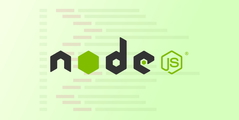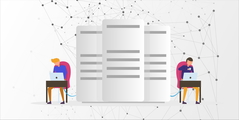In today’s fast-shifting digital economy, competitive advantage is no longer defined by size or legacy; it’s shaped by speed, adaptability, and experience. The businesses positioned to lead in 2025 are those delivering seamless, intelligent, and purpose-built digital experiences. Increasingly, that edge is powered by modern web applications, not just as tools but as engines of transformation.
From self-service customer portals to composable B2B platforms and AI-driven internal systems, web applications now sit at the core of how organizations engage customers, empower teams, and scale operations. According to IDC, over 70% of customer and employee experiences will be driven by purpose-built applications by 2025. This shift reflects a broader truth: web application development is no longer just a technical function; it’s a business-critical strategy.
Yet, the development process has evolved. Success today means aligning application development with business goals, designing around user needs, and integrating technologies like AI and cloud to create systems that adapt and scale.
This guide breaks down the modern web application development process step by step, offering strategic insights to help business leaders reduce risk, accelerate innovation, and build digital products that are ready for what’s next.
Why businesses must understand modern web application development
Modern web application development isn’t just a technical shift; it’s a business strategy. In 2025, every dital interaction, from sales to service, runs through apps. For mid-sized enterprises, understanding how modern apps are built, scaled, and secured is critical. It’s the difference between leading and lagging, between meeting customer expectations and losing them. The stakes are high. The time to understand is now.
1. Customer expectations have radically shifted
Today’s customers, whether B2C or B2B, expect digital experiences that are fast, frictionless, and personal. They use multiple devices, expect 24/7 accessibility, and quickly disengage from apps that feel clunky or outdated.
- Responsiveness, accessibility, and security are now table stakes.
- Retail buyers expect seamless cart-to-checkout experiences across channels.
- In manufacturing, partners expect real-time visibility into supply chain portals
Failing to meet these expectations doesn’t just lose a user; it weakens brand trust.
2. Speed-to-market is the new competitive edge
In 2025, time-to-value is everything. Whether you’re rolling out a new feature or entering a new channel, how fast you deliver matters more than ever.
- Agile methodologies, CI/CD pipelines, and DevOps culture allow for faster delivery and feedback loops.
- Enterprises that understand these practices can ship weekly, not yearly.
- U.S.-based distribution companies, for example, are now deploying same-day feature updates to meet customer SLAs.
Outpacing your competitors often comes down to understanding and enabling modern development velocity.
3. Security & compliance are business critical, not just IT concerns
With rising cyber threats and evolving regulations (GDPR, HIPAA, PCI DSS), security is no longer a back-end consideration. It’s embedded in the first line of code.
- DevSecOps has emerged as the new baseline, integrating security into every phase of development.
- For regulated industries like retail, manufacturing and logistics real-time audibility is a must.
- U.S. mid-sized enterprises are now required to demonstrate continuous compliance, not just pass annual audits.
Modern application development ensures data protection, business continuity, and legal readiness.
4. Cloud-native architectures have replaced monolithic thinking
Legacy, monolithic systems can’t scale or adapt fast enough to meet modern demands. Cloud-native models, using microservices, containers, and serverless functions, are the new normal.
- They offer elastic scaling, faster deployment, and reduced downtime.
- Mid-sized retailers moving to Kubernetes-based architecture have reported 60% faster deployment cycles.
- Platform engineering enables repeatability and resilience at scale.
Understanding these architectures enables cost control and future-ready scalability.
5. Data-driven development powers smarter innovation
Modern web application aren’t just about functionality; they’re about learning. Every user clicks, delay, or abandonment is a signal.
- Real-time analytics, observability, and AI allow businesses to build smarter with each release.
- Enterprises that architect with data feedback loops can fine-tune user experiences on the fly.
- Manufacturers using application telemetry now optimize workflows with real-time insights from shop-floor systems.
Development isn’t complete until outcomes are measured and improved.
6. Legacy systems are quietly holding you back
Outdated systems still “working” are often quietly limiting growth.
- They slow down innovation, increase maintenance costs, and restrict integrations with modern tools.
- Understanding modern app development helps leaders identify what to rebuild, refactor, or retire strategically.
- For example, a U.S. logistics company modernized its warehouse interface layer without disrupting fulfillment workflows, unlocking 3x faster updates.
Modernization doesn’t mean rip-and-replace; it means making legacy work smarter.
7. Talent, tools, and team structures have transformed
Web development is no longer a single developer’s job; it’s an integrated, cross-functional effort.
- Teams now include full-stack developers, DevOps engineers, cloud architects, and platform product owners.
- Tools like GitOps, Infrastructure as Code (IaC), and API-first platforms are now essential.
- Mid-size enterprises that adopt modern workflows attract better talent and improve team velocity.
Understanding these shifts is key to building high-performing tech teams in 2025.
8. Modern development enables continuous innovation
Gone are the days of “build once, release once.” Continuous delivery means ongoing iteration, testing, and learning.
- Modern development frameworks enable A/B testing, feature toggling, and blue-green deployments.
- Businesses that embrace this mindset launch updates daily, staying ahead of customer needs.
In 2025, innovation is no longer episodic; it’s engineered into the process.
9. Business and tech strategies must now move together
Finally, technology execution is inseparable from business success.
- Every feature must tie to a KPI: customer retention, operational efficiency, or revenue uplift.
- Decision-makers must understand enough to ask the right questions, prioritize the right investments, and align innovative product development with enterprise goals.
Understanding modern web application development empowers better strategic decisions, not just better software.
This isn’t just for your tech team
Modern web application development is no longer the sole responsibility of developers or CTOs. In 2025, it’s a strategic lever that shapes how you grow, differentiate, and compete.
The enterprises that thrive are the ones where business leaders understand not just what’s being built but how, why, and how fast. The time to learn is now.
What web application development looks like today (vs. the past)
Web application development has radically evolved. What once took months now happens in weeks or even days. The shift isn’t just about speed, but about agility, modularity, and alignment with ever-changing business demands.
To help you clearly understand this transformation, we’ve outlined a direct comparison between traditional development practices and the modern, future-ready approaches that define web application development in 2025.
| Area | Then (Traditional) | Now (Modern) |
| Architecture | Monolithic, tightly coupled systems | Modular, microservices-based, loosely coupled |
| Development method | Waterfall, long cycles, delayed feedback | Agile + DevOps, CI/CD, continuous iteration |
| Infrastructure | On-prem or shared hosting, limited scalability | Cloud-native, serverless, containerized (e.g., Kubernetes) |
| Team collaboration | Siloed departments: dev, QA, UX worked in isolation | Cross-functional teams using shared tools and goals |
| UX & design | Basic UIs, poor responsiveness, accessibility ignored | UX-first, responsive, WCAG-compliant, data-informed design |
| Quality assurance | Manual testing at the end of the cycle | Automated, shift-left testing, integrated monitoring |
| Product strategy | Assumption-driven features, static roadmaps | Analytics-driven, A/B testing, real-time user feedback |
| Deployment | Infrequent, risky big-bang releases | Continuous delivery, feature flags, instant rollbacks |
| Security & compliance | Late-stage security, bolt-on compliance | DevSecOps: built-in security throughout development |
| User personalization | One-size-fits-all experiences | API-first, AI-personlized, dynamic content |
Understanding how web development has evolved is only the beginning. Now, let’s walk through the modern web application development process, starting with aligning every build to your business strategy and goals.
Phase 1: Strategy and business alignment
Building a successful web application starts not with code but with clarity. For executives shaping tomorrow’s digital enterprises, the real power lies in defining a business-aligned web app strategy that connects directly to measurable outcomes. In 2025, with rising expectations around personalization, speed, and scalability, your application development strategy must go beyond functionality; it must deliver strategic value.
1. Define the problem or opportunity your web application will solve
Every strong strategy for application development begins by answering one question: What meaningful business problem is this application solving? Whether it’s improving internal efficiency, enhancing user experience, or enabling new digital revenue streams, clarity at this stage creates direction. McKinsey data shows that well-scoped initiatives are 30% more likely to achieve expected ROI because teams are aligned around impact, not output.
2. Map web application objectives to broader business KPIs
Your web application strategy must directly contribute to core business KPIs such as customer acquisition cost (CAC), operational efficiency, or net promoter score (NPS). For instance, a self-service portal could be tied to reducing support ticket volume, improving user satisfaction, or increasing retention. This linkage ensures your application development delivers outcomes the business truly values.
3. Choose the right development model: Custom, SaaS, or Low-code
Your application development approach must reflect your goals, resources, and pace of innovation:
- Custom development offers full control and scalability, ideal for complex or high-differentiation products.
- SaaS solutions accelerate time-to-market but may constrain flexibility.
- Low-code platforms provide speed and accessibility, particularly effective for internal tools and MVPs.
Making the right choice upfront minimizes technical debt and aligns the solution to both short-term needs and long-term growth.
4. Understand your target users and their digital behavior
Deep user insight is non-negotiable. According to Gartner, 75% of digital initiatives underperform due to a lack of product adoption. Understanding your audience’s pain points, expectations, and digital habits helps you craft an experience that encourages not just use but user retention. Use analytics, interviews, and early feedback loops to embed empathy into your product decisions.
5. Build a realistic scope, timeline, and budget
Don’t try to build everything at once. Instead, define a clear minimum viable product (MVP) that delivers core value fast. Research shows that phased rollouts reduce time-to-market by up to 40%. Your roadmap should include realistic estimates, clear milestones, and contingency buffers, ensuring the development process earns stakeholder confidence and stays resilient under pressure.
6. Create a success matrix: Measure performance, ROI, and adoption
To manage what matters, measure what matters. Before a single sprint begins, define success criteria linked to business KPIs, such as engagement rate, conversion, or operational savings. Frameworks like OKRs help you track these metrics across the application development lifecycle, guiding smart decisions and scaling strategies.
When your web application development is rooted in clear business goals and aligned with what users truly need, it stops being a siloed project and becomes a strategic asset. This first phase sets the foundation for continuous growth, faster delivery, and sustained market relevance.
Phase 2: Designing for usability, accessibility, and scalability
Great application development in 2025 starts with design that works for everyone. Prioritizing usability, accessibility, and scalability ensures your web app is easy to use, inclusive by design, and ready to grow driving adoption, reducing friction, and setting the foundation for long-term performance and meaningful business outcomes.
1. User-centric design: A business imperative in 2025
Today’s users expect more than features; they expect seamless, frictionless journeys. Usability isn’t just about aesthetics; it’s about reducing cognitive load, guiding users with clarity, and anticipating their intent.
A well-designed application improves task completion rates, reduces support queries, and drives engagement, directly impacting business KPIs like customer satisfaction (CSAT), conversion rate, and time-to-value.
Example (Retail web application – Same-day delivery): A Munich retail network built a user-friendly web app with easy order submission and real-time tracking. This MVP quickly gained adoption, boosted customer loyalty, and created a clear competitive edge in delivery speed.
2. From concept to clarity: Wireframing and prototyping
Before a single line of code is written, design thinking begins with wireframes and interactive prototypes. These tools allow stakeholders to visualize the app’s flow, catch UX issues early, and align business logic with user behavior.
Collaborative prototyping bridges the gap between business intent and user reality, ensuring product, design, and tech teams are building the right thing from the outset.
Tools like Figma and Adobe XD allow real-time collaboration between cross-functional teams, reducing costly redesigns later in development.
3. Accessibility by default: Inclusive design as a standard
Accessibility is no longer an afterthought; it’s a requirement. Inclusive design ensures that applications are usable by people with disabilities, from visual and motor impairments to cognitive challenges.
Designing with WCAG 2.2 guidelines in mind not only broadens your reach but also protects your brand from compliance risks and aligns with values of equity and inclusion.
According to WHO, over 1.3 billion people experience significant disability globally. Making your web application accessible means you’re not leaving business or people behind.
4. Mobile responsiveness: Every screen, every time
With users interacting across desktops, tablets, and smartphones, responsive design ensures your application performs consistently across all screen sizes.
A mobile-first or device-agnostic approach helps maintain functionality and usability no matter the context, which is crucial for field teams, remote users, or fast-paced consumers.
Whether it’s a B2B field ops platform or a customer-facing eCommerce portal, responsiveness translates directly into usability and user trust.
5. Cross-team collaboration: Bridging product, design, and business
Great design isn’t built in silos. In high-performing organizations, product managers, UX designers, and business stakeholders work as a unified team from the start.
This integrated approach ensures that design decisions are anchored in business goals, shaped by real user insights, and supported by scalable tech architecture.
Aligning design reviews with product roadmaps and business OKRs leads to faster feedback loops and greater strategic clarity.
6. Designing for scale: Future-proofing interfaces and flows
As your business evolves, your application must evolve with it. The scalable design anticipates future states, adding new features, serving growing user bases, or integrating emerging technologies without overhauling core UX.
This means designing modular interfaces, reusable components, and extensible user flows that adapt to business and market changes.
Future-ready design saves engineering cycles, reduces technical debt, and positions your application as an enduring competitive asset.
When you put usability, accessibility, and scalability at the heart of your design, you’re creating more than just an application, you’re crafting an experience users trust and depend on. This approach removes obstacles, accelerates growth, and enables your application to evolve alongside your business.
Phase 3: Choosing the right tech stack and architecture in 2025
In 2025, choosing the right tech stack isn’t just about technology; it’s about building growth. The foundation you select today determines how fast you can innovate, how well you can scale, and how smoothly your app integrates into an increasingly connected digital ecosystem.
1. Trends and best-fit stacks (React, Next.js, Node.js, etc.)
Today’s leading front-end frameworks, React, Next.js, and Vue.js, offer component-based development, excellent performance, and SEO readiness.
React remains dominant for dynamic user interfaces, while Next.js adds capabilities like server-side rendering and static generation, ideal for high-performance customer-facing apps. These tools strike a balance between developer efficiency and user experience, making them foundational to modern digital products.
2. Choosing backend frameworks for performance and flexibility
Backend frameworks must align with business complexity and performance goals. Node.js offers lightweight, non-blocking I/O for real-time applications, while Django (Python) is known for rapid development and strong security out of the box.
Spring Boot (Java) provides enterprise-grade scalability and robust microservices support. Your choice should reflect not only performance needs but also your team’s capabilities and the expected lifecycle of the product.
3. Microservices vs. Monoliths: What suits your business?
Microservices allow teams to build, deploy, and scale components independently, an ideal fit for organizations seeking agility, modularity, and rapid innovation cycles. However, they also introduce operational complexity.
A monolithic architecture may suit simpler projects or early-stage products, offering ease of development and deployment. For most growing enterprises, a microservices-based or hybrid approach is the future-proof path.
4. Database choices: Relational, NoSQL, cloud-native
Database selection hinges on data structure, consistency requirements, and scaling expectations.
- Relational databases (e.g., PostgreSQL, MySQL) provide strong consistency and structured query support ideal for transactional systems.
- NoSQL databases (e.g., MongoDB) excel in flexibility and performance for unstructured or rapidly evolving data models.
- Cloud-native databases (e.g., Amazon Aurora, Google Firestore) offer built-in scalability, high availability, and seamless cloud integration, perfect for applications with fluctuating workloads.
5. Integration considerations (CRM, payment, analytics tools)
In 2025, integration is a strategy. Web applications must seamlessly connect with CRM platforms (e.g., Salesmate), payment gateways (e.g., Stripe, Razorpay), and analytics engines (e.g., Mixpanel, GA4). API-first architecture enables flexible, secure, and scalable integrations that enhance customer experiences and allow real-time business insights without overhauling core systems.
6. Cloud-native infrastructure and DevOps readiness
Cloud-native architecture built on containerization (Docker), orchestration (Kubernetes), and managed cloud services is essential for resilience and elasticity. Pairing this with DevOps practices like CI/CD, automated testing, and infrastructure-as-code ensures your team can deliver faster, safer releases and adapt to changing demands with minimal friction. This operational maturity accelerates innovation and minimizes downtime.
The choices you make today about your tech stack and architecture determine how swiftly your business advances tomorrow. Opt for a strategy that not only supports your goals but accelerates their achievement.
Phase 4: Align development with strategic execution
Once design is complete and stakeholder alignment is in place, the focus shifts to execution. But for business leaders, web application development isn’t just a technical activity; it’s the stage where strategic intent must be safeguarded and transformed into a scalable, working product. How development is approached determines whether your web application will deliver measurable outcomes or just functional outputs.
1. Establish business-aligned development workflows
Successful execution starts with structured workflows that mirror your strategic goals. Whether your teams operate in-house, hybrid, or outsourced models, define clear delivery milestones that align with business objectives, not just technical completion. Encourage visibility into progress across departments so business, product, and engineering teams remain connected throughout the process.
2. Govern collaboration and accountability
Version control and collaboration tools (like Git, Jira, or Azure DevOps) are essential, but so is leadership oversight. Establish governance mechanisms that promote transparency, enforce accountability, and enable stakeholders to quickly identify blockers. Use sprint reviews and demos not only to assess progress but also to evaluate how well features align with original KPIs and customer needs.
3. Prioritize strategic integrations from day one
Every integration, whether with a CRM, ERP, or payment platform, must serve a business purpose. Ensure that your development plan includes a blueprint for seamless integration with your existing tech stack. Poorly planned APIs or middleware can become long-term liabilities, slowing down processes or creating fragmented data flows.
4. Build with security and compliance in mind
Security should be integrated into the development lifecycle, not treated as an afterthought. Embedding controls such as data encryption, access management, and compliance checks (e.g., GDPR, HIPAA) during development reduces risk, avoids costly rework, and accelerates stakeholder trust, especially in regulated industries.
5. Embrace agile for value delivery, not just speed
Agile development isn’t just a methodology; it’s a business advantage. Sprint cycles should be framed around delivering usable value to end users and validating business assumptions quickly. Encourage continuous stakeholder involvement, incorporate user feedback into backlog grooming, and treat each release as a step toward ROI, not just functionality.
Your application development phase is where strategy transforms into software. Protect that strategy by ensuring execution is structured, visible, secure, and aligned with continuous value delivery. When done right, application development isn’t just fast, it’s focused, accountable, and designed for measurable business impact.
Phase 5: Testing, QA, and deployment readiness
Delivering reliable, secure, and high-performing software requires a disciplined approach to testing, quality assurance, and deployment preparation. Each phase ensures the product meets business needs and operates flawlessly in production.
1. Functional, usability, performance, and regression testing
Functional testing verifies all features to meet requirements, while usability testing ensures intuitive user interactions that drive adoption. Performance testing identifies bottlenecks under realistic load conditions to guarantee scalability. Regression testing safeguards existing functionalities against new code changes, maintaining system stability.
2. Automated testing pipelines and test coverage
Automation accelerates testing cycles and improves accuracy through continuous execution of unit, integration, and end-to-end tests. Comprehensive test coverage metrics spotlight potential gaps, enabling proactive quality management and faster feedback loops integral to agile development.
3. Security testing and vulnerability scanning
Embedding security early through static and dynamic testing uncovers vulnerabilities before deployment. Continuous vulnerability scanning integrated into CI/CD pipelines ensures ongoing risk mitigation, safeguarding software against evolving threats and compliance violations.
4. CI/CD pipelines for faster and reliable releases
CI/CD pipelines automate builds, tests, and deployments, reducing manual errors and accelerating release frequency. This automation enables safe, incremental rollouts with rollback options, improving release confidence and operational agility.
5. Pre-deployment checklist for business-critical readiness
A structured pre-launch review confirms environmental consistency, configuration accuracy, backup readiness, and monitoring setup. Final stakeholder validations and contingency planning secure operational stability and rapid incident response post-deployment.
6. Cloud deployment (AWS, Azure, GCP): Choosing wisely
Selecting the right cloud platform hinges on aligning service capabilities with workload demands, compliance requirements, and cost efficiency. AWS offers broad services, Azure excels in Microsoft ecosystem integration, and GCP leads in data analytics; decision criteria must reflect strategic business priorities.
This comprehensive focus on testing, quality assurance, and deployment readiness ensures software is thoroughly validated, secure, and prepared for seamless release, minimizing risk and maximizing business continuity.
Phase 6: Go-to-market and launch strategy
An effective go-to-market and launch strategy is crucial to transform a web application from development success to business impact. Aligning every launch element with overarching business and marketing goals ensures maximum reach, adoption, and sustained growth.
1. Aligning application launch with business and marketing goals
The launch strategy must be deeply integrated with the company’s strategic objectives, whether driving revenue, expanding market share, or enhancing brand equity. Clear KPIs aligned to these goals to guide prioritization of features, target audience selection, and messaging frameworks to ensure measurable outcomes.
2. Beta testing, early access programs, and stakeholder feedback
Controlled beta releases and early access programs serve as critical validation mechanisms. Engaging real users and stakeholders in these phases provides actionable insights, uncovers usability issues, and refines product-market fit ahead of full launch, reducing market risks.
3. Launch readiness checklist: Tech, ops, legal, marketing
A comprehensive readiness checklist ensures cross-functional alignment before launch. This includes final system performance validation, operational support readiness, compliance and legal approvals, and marketing campaign execution plans—minimizing surprises and ensuring seamless execution.
4. Promotion strategies: SEO, email, social, PPC
Multi-channel promotion drives visibility and user acquisition. SEO ensures organic discoverability, email campaigns nurture engaged audiences, social media builds community and buzz, while PPC accelerates reach through targeted advertising. Integrated campaigns maximize ROI and brand resonance.
5. User onboarding and training for adoption
Effective onboarding accelerates user proficiency and satisfaction. Personalized tutorials, contextual help, and interactive training empower users to realize value quickly, reducing churn and fostering long-term engagement.
Phase 7: Continuous improvement and scaling for growth
Beyond launch, long-term success depends on how effectively an application evolves to meet changing user expectations, usage patterns, and business objectives. This phase focuses on iterative improvement, scalable architecture, and strategic adaptability.
1. Measuring success: Product KPIs, NPS, retention, churn
Tracking clear performance metrics, such as feature adoption, net promoter score (NPS), user retention, and churn, provides a data-backed view of product health and user satisfaction. These insights inform investment decisions and highlight friction points that impact growth.
2. Building feature roadmaps from usage data and feedback
Real-time analytics and structured feedback loops enable product teams to prioritize enhancements that deliver the most value. Feature roadmaps grounded in user behavior, not assumptions, accelerate product-market fit and drive continuous relevance.
3. Scaling infrastructure (Auto-scaling, Global availability)
Growth requires a responsive backend. Auto-scaling infrastructure adjusts resources based on demand, ensuring performance under peak loads. Deploying across global regions enhances latency, uptime, and user experience, which is especially critical for geographically distributed audiences.
4. Preparing for future needs: Localization, multi-tenant support
Scalability also means anticipating complexity. Localization ensures relevance across languages and regions. The multi-tenant architecture supports the efficient onboarding of multiple clients without compromising data isolation, enabling efficient expansion into new markets.
5. Supporting business evolution with modularity and agility
Modular architecture and API-first design enable faster adaptation to emerging business needs. Agility becomes a strategic asset, allowing organizations to integrate new technologies, pivot offerings, and support evolving customer requirements without overhauling core systems.
Unlock the full potential of your web application journey
You’ve walked through the essential steps of the web application development process, each phase designed to help you build not just software but a strategic asset that drives growth, engagement, and lasting impact. This journey isn’t just technical; it’s deeply tied to your business vision, your users’ needs, and the future you want to create.
At Rapidops, with over 16 years of hands-on experience, we’ve partnered with businesses across industries to navigate these exact challenges. Whether you’re modernizing legacy systems, addressing user adoption hurdles, accelerating time-to-market, or exploring AI-powered innovation, we understand the diverse realities you face. Our work is grounded in aligning technology with business goals and delivering measurable outcomes, adapting flexibly as your needs evolve.
We know that every organization’s situation is unique; whether you’re refining your strategy, scaling your platform, or starting from scratch, getting the right guidance early can make all the difference. Schedule an appointment with one of our web application development experts to gain tailored clarity, actionable insights, and a clear path forward specific to your goals.

Rahul Chaudhary
Content Writer
With 5 years of experience in AI, software, and digital transformation, I’m passionate about making complex concepts easy to understand and apply. I create content that speaks to business leaders, offering practical, data-driven solutions that help you tackle real challenges and make informed decisions that drive growth.
What’s Inside
- Why businesses must understand modern web application development
- What web application development looks like today (vs. the past)
- Phase 1: Strategy and business alignment
- Phase 2: Designing for usability, accessibility, and scalability
- Phase 3: Choosing the right tech stack and architecture in 2025
- Phase 4: Align development with strategic execution
- Phase 5: Testing, QA, and deployment readiness
- Phase 6: Go-to-market and launch strategy
- Phase 7: Continuous improvement and scaling for growth
- Unlock the full potential of your web application journey

Let’s build the next big thing!
Share your ideas and vision with us to explore your digital opportunities
Similar Stories
- Engineering
- undefined Mins
- September 2022

- Engineering
- undefined Mins
- January 2016

- Engineering
- 5 Mins
- November 2015


Receive articles like this in your mailbox
Sign up to get weekly insights & inspiration in your inbox.
